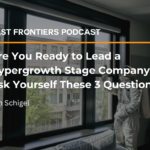Sometimes simplicity is key. When we built Refinery Ventures, we did so methodically, brick-by-brick, giving us the best possibility to position ourselves as a rising star to success. This article will cover the “four lessons learned,” and what I consider to be the foundation of Refinery.
These four lessons involve the integral components of sourcing, portfolio construction, discipline, and execution. They are all key to incorporate on your road to success… these building blocks are what separate the best from all the rest.
1) Sourcing Is Everything
The first lesson learned is that sourcing is everything. I cannot emphasize enough how important finding the companies and founders and creating a pipeline to discover unique companies is.
There are two ways to think about firms that have done well. The first is that you make a great investment which lands a large and early exit, then suddenly, your deal flows much better. If you’re lucky enough to have that happen, that’s great, but most firms aren’t. Simply put: early successes pay dividends. People come back to you because you invested in that great company. It is incredible when it occurs, but it’s hard to design for that type of success!
The second method is to become a domain expert in an area where you become the go-to investor because you know more about Blockchain than anybody else. In this way you’re not dependent on the high-profile exit, but you create a great pipeline.
Think about sourcing as the “inbound” and the “outbound” dealflow, where the inbound is based on professional networks and past successes. As for our outbound, it’s very explicit. Ours consists of geographical (we’re currently combing the Great Lakes area more thoroughly than anywhere else in the country since it’s our backyard), and we will go deeper in a domain area, such as health tech.
Bottom line: Before the construction, you have to have a sourcing strategy. You can’t just take it for granted.
2) Portfolio Construction
This brings us to the second lesson learned, which is portfolio construction. Refinery’s answer to success when it comes to portfolio construction, is to get as much ownership as possible.
Our philosophy is that the best check you write in a successful company is the first check . And we want sufficient ownership so that each investment has the potential to return the whole fund.
Think of it this way: You can make 100 bets, and 99 of them could all lose money, but as long as one is a big winner, it doesn’t matter. A great quote from Bill Gurley, who is a partner at Benchmark, encapsulates this so well. Gurley stated that “Venture isn’t about home runs, it’s about grand slams,” and it’s so true.
But we take this a step further, and we’re not going to have a ton of companies, we’re going to have 10 to 12 in each portfolio. We are highly selective, investing in companies that are likely to go from a million to 10 million in revenue in 24 months—so basically only those poised for hyper-growth. And we’re going to get good enough ownership in those companies from a portfolio construction standpoint, that our returns are going to be great.
3) Follow On Discipline
The third lesson learned is follow on discipline. This means not investing more money in companies that don’t have the potential to return the fund. Historically, venture capital is about a 40% write off rate on a deal basis. This means that 40% of your companies that you invest in are probably not going to return capital.
Knowing this, very early on (after you write the first check), you have to ask the hard questions: Is it worth trying to keep this company alive or not? Should I put more money into the company?
It all comes down to knowing when to be honest with the entreprenuer, and unfortunately, firms are notoriously bad at doing this. To do this—and to do it well—it takes internal discipline and a dignified approach.
For example, let’s say your company was struggling just to hit its revenue numbers, and it wasn’t looking like it was going to work the way you were hoping. Instead of just waiting for something to happen, you might go to the CEO and say, “You know what? This was an excellent idea. We thought this thing was going to go, but it looks a lot harder than we thought.”
At that point, you should look to see if you can merge the company with a strategic partner. Then what you’ve built might still have a chance to survive (and everybody might have a better chance of making some return on their investment instead of just being kept alive as a zombie company).
Because let’s face it, there are a lot of zombie companies out there that are just kind of existing. There are countless reasons for this. People don’t want to shut things down. they want to save jobs, and they’re also trying to protect reputations. There are many reasons to keep companies alive. But the fact remains that private companies are not the stock market. You can’t just buy and sell it like stock. In these cases, you’re better off selling it for something and getting it out of your inventory as a VC.
4) Consistent Execution Against Strategy
The last lesson learned is about consistent execution against strategy. So many times, venture firms will say, “this is our strategy,” but then when you look at their investments, they don’t seem to correlate to that strategy. Essentially, people don’t match up what they’re doing with what they said they’re going to do.
To avoid this, you must ask yourself: Is there consistency? Specifically, is there a consistent narrative to why you’re investing? There always will be exceptions, but if exceptions become the rule, they’re not exceptions anymore.



